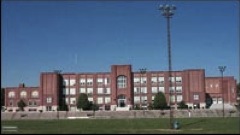Do content areas play together?

Districts are slow to learn this lesson. They still see each department as individual “silos” in foreign policy speak or islands unto themselves. Yes, they may spout some PC integration speech, but the way curriculum is developed and then presented to the school boards individually does not lend itself to a comprehensive outlook but a segmented one. If a school board is asked to increase funding for one department, will it consider funding requests by departments who will give their curriculum reviews two or three years later?
The asst. supe for curriculum would act as a “czar” in Obama’s world (why are we using Russian terminology?), but I’m not convinced that that is enough. I’m not advocating for the dissolution of departments; rather, I would like to see a change of methods used in curriculum planning at a district level.
I chose Parkway by random and searched its Board Docs for math. It completed the last comprehensive math review (pdf) in 2006 and, as is traditional, will review it again in another five years with updates in between. In going over the report given to the board and posted on the Board Docs, no mention is given to how the math department is connected to the other departments. Nor is any mention given to how recommendations would affect other departments.
I decided to check if its neighbor Rockwood had shown wider thinking. Nope, and their latest math review (pdf) was just approved this January. However, I do like Rockwood’s Curriculum Advisory Council, which looks over completed curriculum reviews and makes their comments/suggestions before they are submitted to the board. The council is made up of teachers, principals, board representatives, parents and students (plus more including counselors, librarians etc.). While I would like for the council to have input before the final document stage, I think this is an excellent idea although it still doesn’t address my concern about looking at the broader picture. At least though the council wouldn’t be made up only of experts in that particular field who tend toward tunnel vision so they could and probably do ask questions about how the proposals affect the wider body. This is an idea that all districts should follow. Maybe we can start to at least build some tunnels between the silos.
Science: What gets tested gets taught

Photo by Adam Baker
Since the MAP is including science now, schools are increasing their focus on teaching science although I’m not sure they have enough.
All of this comes as economic and education experts worry about U.S. global competitiveness.
“We should be embarking immediately on an all-hands-on-deck, no-holds-barred, no budget-too-large crash program for science and engineering education.” (Thomas L. Friedman in The World is Flat 3.0)
Missouri needs to increase its state requirements for graduation. All students need to take biology, chemistry and physics (not necessarily in that order). Students graduating in 2010 are required to take three years (same as math and history), which is an increase from the currently required two years. I think all students should take four years of all four core subjects. Most schools don’t require physics, but the concepts are essential in science and can be taught to all. (See previous post on teaching physics first.)
For example, Hazelwood currently requires students to take Physical Systems and Chemical Systems, each a semester course. Then students are required to take biology for a year. This includes students with a College Prep designation on their diploma. With the requirement increase, students are then required to add another year of science of their choice. Only one semester of chemistry? They offer a full year of chemistry but don’t require it. This is not enough science for people competing with other countries for jobs and deciding on the direction of science via elections.
Francis Howell currently requires a year of physical science and a year of biology. Chemistry and physics are optional.
Elementary schools need to increase the emphasis on science and integrate science with math and reading.
MRH, which has a helpful curriculum online, does not include science K-5. Is it not important enough?
Rockwood does include a grade-by-grade detailed list of its science curriculum starting at the K level. It also puts on a Science Expo at the beginning of the year to stir up excitement and let the students and parents know of science resources available in St. Louis.
Mehlville doesn’t include the detail that Rockwood does, but it gives an easy to decipher overview of the content covered in each grade, the name of the textbook used (!) and suggested resources and activities for families. As an educator I like the Rockwood detail, but the Mehlville overview is definitely more readable. I would like districts to include both.
I looked at the 2008 MAP 5th grade science scores comparing median MAP scale scores. None of the top 10 in the state were in the St. Louis metropolitan area, but none of them had more than 27 students taking the test, so I narrowed my list to districts in the metropolitan area, including charter schools. The top school districts were not surprising, but I was intrigued by some of the districts on the list such as Washington, Windsor and Fox. Parkway was 16th. Union and Festus were 11 and 12.
| DISTNAME | MEDIAN_SCALE_SCORE |
| ROCKWOOD R-VI | 684 |
| LADUE | 682 |
| KIRKWOOD R-VII | 680 |
| CLAYTON | 680 |
| LINDBERGH R-VIII | 677 |
| BRENTWOOD | 676 |
| WEBSTER GROVES | 676 |
| WINDSOR C-1 | 674 |
| FOX C-6 | 674 |
| WASHINGTON | 673 |
I then searched to see if the same districts had the highest number of students scoring at the advanced level.
| DISTNAME | ADVANCED_PCT |
| ROCKWOOD R-VI | 39.6 |
| LADUE | 36.2 |
| CLAYTON | 30.2 |
| KIRKWOOD R-VII | 28.9 |
| WEBSTER GROVES | 28.5 |
| LINDBERGH R-VIII | 25.4 |
| ORCHARD FARM R-V | 22.9 |
| WASHINGTON | 22.3 |
| FOX C-6 | 22.2 |
| JEFFERSON CO. R-VII | 20.2 |
Most of the districts were the same with Orchard Farm joining the list and Windsor falling to 11. Parkway moved up to 12.
Sorting by median Terra Nova scores shuffled the districts a bit bringing New Haven (Franklin Co. R-II) into the top.
| DISTNAME | MEDIAN_TERRANOVA |
| ROCKWOOD R-VI | 82.0 |
| CLAYTON | 81.0 |
| BRENTWOOD | 80.0 |
| KIRKWOOD R-VII | 79.0 |
| LADUE | 77.0 |
| FRANKLIN CO. R-II | 77.0 |
| WEBSTER GROVES | 76.0 |
| UNION R-XI | 74.0 |
| FOX C-6 | 73.5 |
| LINDBERGH R-VIII | 73.0 |
Rockwood comes out on top in every configuration. Whether it is the Science Expo, detailed expectations or another reason altogether, the elementary schools there come ahead.
I’ll be interested to watch whether this new focus on science raises everyone’s scores.
Put that curriculum on the website!

Rockwood: detailed information on curriculum by content area, info on curriculum development, easy-to-use website
Mehlville: pdf of each grade and high school
MRH: pdf of each school level (elementary, middle, high) and content area, assessment report, easy-to-use website
Clayton: info on curriculum development including names of curriculum coordinators but not information on content level or grade level objectives
Ladue: info limited to elementary math under the district curriculum section
Ferguson-Florissant: no information on district site that I could find via browsing or by search, no info in at least two elementary schools (Airport Elementary, Bermuda Elementary)
SLPS: no information that I could find via browsing, no search available; no info in at least three elementary schools (Adams, Ashland and Cote Brilliante)
Since curriculum drives education, I applaud Rockwood and MRH for having comprehensive, easy-to-use curriculum sections on their websites. Clayton and Ladue have some catching up to do. Ferguson-Florissant and the SLPS are embarrassingly lacking in this area. While I didn’t look at every district’s website, I encourage educators to think about what they include and emphasize on their websites and the message that sends to their parents and broader community.
Need for more transparency, participation in education

Photo by GPTwisted
As quickly as the financial
School districts can learn from the Sunlight Foundation and involve the community earlier in the process. Some St. Louis County districts use BoardDocs to post agendas, minutes and supporting documents in an easy-to-access manner. (See Rockwood for an example)
I would like to see them go one step further and open up documents for a public markup period before they make it to the board presentation stage. For example, if a committee is going to recommend changes to content area’s curriculum, posting the proposed changes before the board presentation allows for more parent involvement than the one or two parents selected to be on the committee. This encourages buy-in or at least allows for time to work on consensus.
Openness and transparency can go a long way to bring our schools into the 21st century.
Greening St. Louis Schools
I have previously challenged districts with building initiatives like Rockwood to include green elements. Parkway is having public meetings where residents can voice their opinions. I'm sure other districts are also considering renovation projects.
Missouri is a bit behind with no LEED certified schools although one is expected to open in Kansas City next year. In St. Louis County, most schools are renovating, not constructing new buildings, which makes the LEED certification trickier. Ohio is requiring all new schools and major renovations to be LEED Silver certified and is helping with funding.
Julia Feder, a green schools advocate for the U.S. Green Building Council St. Louis Chapter, spoke last night (Tues. Feb. 12) to the Clayton school district about the advantages of building green and the "triple bottom line."
Good for environment
nuff said
Good for economics
While building green costs 3-5% more, the payback time is 5-7 years. Obviously, schools last longer than that, so taxpayers benefit. The average green school saves $100,000 per year in operating costs.
❝Analysis of the costs and benefits of 30 green schools and use of conservative and prudent financial assumptions provides a clear and compelling case that greening schools today is extremely cost-effective, and represents a fiscally far better design choice. Building green schools is more fiscally prudent and lower risk than continuing to build unhealthy, inefficient schools.❞ (Greening America's Schools: Costs and Benefits, Gregory Kats, Capital E Report, pdf)
Good for health and wellness
An AIA (American Institute for Architects) report gives some promising data: 38.5 percent reduction in asthma because of improved air quality and 1.41 fewer teacher work days missed. (eSchool News) Improving kids' health because of better building design and implementation is a moral obligation.
Illinois has passed the Green Cleaning for Schools Act, which will help all schools take steps toward making schools a healthier environment. Will Missouri step up?
Learning
A Heschong Mahone Group study showed that daylighting, contrary to previous assumptions, doesn't decrease learning. Instead, students showed a 20-26 percent faster learning rate. I remember the middle school I attended with its miniscule windows. Sigh.
Studies have linked a decrease in ADHD behaviors to time spent in the outdoors. Outdoor classrooms are another component to green schools.
USGBC-STL is giving a presentation "Greening Your School and District 101: What do you need to know to take the first steps?" at Crossroads Preparatory School April 3 8-10 a.m.
Education builds green

St. Louis Community College-Wildwood
Building green is popular here in St. Louis with commercial and residential properties having or going for LEED certification. Higher ed is getting on the bandwagon.
St. Louis Community College opened a fourth campus this year at Wildwood. The first building is going for LEED Gold with its green roof and daylight lighting.
St. Louis University built a new research facility that is connected to its med school. That facility is going for LEED Silver with its efficient, open space. Few labs go for LEED certification, so kudos to SLU. It also has a partial green roof.
Not to be outdone, Wash U opened its Danforth Center (student center), which is going for LEED Gold.
Universities are greening up because of the educational and environmental aspects.
❝To a large extent, the push is coming from the ground up, fueled by students' passions and interests and enthusiasms," says Peter MacKeith, associate dean in the School of Architecture at Washington University in St. Louis.❞
I could not find any secondary schools that were being built to meet even LEED certification including the new CBC campus. MRH built a new elementary school. While the school is beautiful, it is not green. Rockwood's 2008 bond issue proposition does not include any green elements even though many additional classrooms are listed. A few, however, are leading the way. (Excel document)
Crossroads College Prep is seeking platinum for its new science wing. (Fox news link)
Hazelwood East
John Burroughs Theatre addition
I had a hard time finding information on Hazelwood or Burrough's projects. I would think they would be telling the world.
I challenge those districts with future building or renovating projects to step up and take leadership. Our kids deserve no less.